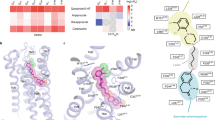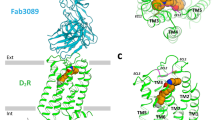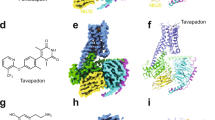Abstract
Current medications for schizophrenia typically modulate dopaminergic neurotransmission. While affecting positive symptoms, antipsychotic drugs have little clinical effect on negative symptoms and cognitive impairment. Moreover, newer ‘atypical’ antipsychotic drugs also have significant metabolic adverse-effects. The recent positive clinical trial of the novel drug candidate SEP-363856, which targets non-dopamine receptors (trace amine-associated receptor and the 5HT1A receptor), is a potentially promising development for the management of schizophrenia. In this perspective, we briefly overview the role of TAAR1 and the 5HT1A receptor in schizophrenia and explore the specific binding characteristics of SEP-363856 at these receptors. Molecular dynamics simulations (MDS) indicate that SEP-363856 interacts with a small, common set of conserved residues within the TAAR1 and 5HT1A ligand-binding domain. The primary interaction of SEP-363856 involves binding to the negatively charged aspartate residue (Asp1033.32, TAAR1; Asp1163.32, 5HT1A). In general, the binding of SEP-363856 within TAAR1 involves a greater number of aromatic contacts compared to 5HT1A. MDS provides important insights into the molecular basis of binding site interactions of SEP-363856 with TAAR1 and the 5HT1A receptor, which will be beneficial for understanding the pharmacological uniqueness of SEP-363856 and for the design of novel drug candidates for these newly targeted receptors in the treatment of schizophrenia and related disorders.
This is a preview of subscription content, access via your institution
Access options
Subscribe to this journal
Receive 12 print issues and online access
$259.00 per year
only $21.58 per issue
Buy this article
- Purchase on Springer Link
- Instant access to full article PDF
Prices may be subject to local taxes which are calculated during checkout


Similar content being viewed by others
References
Insel TR. Rethinking schizophrenia. Nature. 2010;468:187–93.
Van Os J, Kapur S. Schizophrenia. Lancet. 2009;374:635–45.
McGrath J, Saha S, Chant D, Welham J. Schizophrenia: a concise overview of incidence, prevalence, and mortality. Epidemiol Rev. 2008;30:67–76.
Jääskeläinen E, Juola P, Hirvonen N, McGrath JJ, Saha S, Isohanni M, et al. A systematic reviewandmeta-analysis of recovery in schizophrenia. Schizophr Bull. 2013;39:1296–306.
Chan SKW, Hui CLM, Chang WC, Lee EHM, Chen EYH. Ten-year follow up of patients with first-episode schizophrenia spectrum disorder from an early intervention service: predictors of clinical remission and functional recovery. Schizophrenia Res. 2019;204:65–71.
Mueser KT, Salyers MP, Mueser PR. A prospective analysis of work in schizophrenia. Schizophr Bull. 2001;27:281–96.
Chan SK, So HC, Hui CL, Chang WC, Lee EH, Chung DW, et al. 10-year outcome study of an early intervention program for psychosis compared with standard care service. Psychological Med. 2015;45:1181–93.
Chan SKW, Chan HYV, Honer WG, Bastiampillai T, Suen YN, Yeung WS, et al. Predictors of Treatment-Resistant and Clozapine-Resistant Schizophrenia: A 12-Year Follow-up Study of First-Episode Schizophrenia-Spectrum Disorders. Schizophr Bull. 2021 Mar 16;47:485-94.
Robinson DG, Woerner MG, McMeniman M, Mendelowitz A, Bilder RM. Symptomatic and functional recovery from a first episode of schizophrenia or schizoaffective disorder. Am J Psychiatry. 2004;161:473–9.
Potkin SG, Kane JM, Correll CU, Lindenmayer JP, Agid O, Marder SR, et al. The neurobiology of treatment-resistant schizophrenia: paths to antipsychotic resistance and a roadmap for future research. NPJ Schizophr. 2020;6:1.
Fusar-Poli P, Papanastasiou E, Stahl D, Rocchetti M, Carpenter W, Shergill S, et al. Treatments of negative symptoms in schizophrenia: metaanalysis of 168 randomized placebo-controlled trials. Schizophr Bull. 2015;41:892–9.
Reynolds GP, Kirk SL. Metabolic side effects of antipsychotic drug treatment-pharmacological mechanisms. Pharm Ther. 2010;125:169–79.
Howes OD, Kapur S. The dopamine hypothesis of schizophrenia: version III-the final common pathway. Schizoprhenia Bull. 2009;35:549–62.
Koblan KS, Kent J, Hopkins SC, Krystal JH, Cheng H, Goldman R, et al. A non-D2-receptor-binding drug for the treatment of schizophrenia. N. Engl J Med. 2020;382:1497–506.
Goff DC. Promising evidence of antipsychotic efficacy without dopamine D2-receptor binding. N. Engl J Med. 2020;382:1555–6.
Leucht S, Arbter D, Engel RR, Kissling W, Davis JM. How effective are second-generation antipsychotic drugs? A meta-analysis of placebo-controlled trials. Mol Psychiatry. 2009;14:429–47.
Berry MD, Gainetdinov RR, Hoener MC, Shahid M. Pharmacology of human trace amine-associated receptors: therapeutic opportunities and challenges. Pharm Ther. 2017;180:161–80.
Lindemann L, Hoener MC. A renaissance in trace amines inspired by a novel GPCR family. Trends Pharm Sci. 2005;26:274–81.
Borowsky B, Adham N, Jones KA, Raddatz R, Artymyshyn R, Ogozalek KL, et al. Trace amines: identification of a family of mammalian G protein-coupled receptors. Proc Natl Acad Sci. 2001;98:8966–71.
Bunzow JR, Sonders MS, Arttamangkul S, Harrison LM, Zhang G, Quigley DI, et al. Amphetamine, 3,4-methylenedioxymethamphetamine, lysergic acid diethylamide, and metabolites of the catecholamine neurotransmitters are agonists of a rat trace amine receptor. Mol Pharmacol. 2001;60:1181–8.
Cao Q, Martinez M, Zhang J, Sanders AR, Badner JA, Cravchik A, et al. Suggestive evidence for a schizophrenia susceptibility locus on chromosome 6q and a confirmation in an independent series of pedigrees. Genomics. 1997;43:1–8.
Lindemann L, Meyer CA, Jeanneau K, Bradaia A, Ozmen L, Bluethmann H, et al. Trace amine-associated receptor 1 modulates dopaminergic activity. J Pharm Exp Ther. 2008;324:948–56.
Revel FG, Moreau JL, Gainetdinov RR, Bradaia A, Sotnikova TD, Mory R, et al. TAAR1 activation modulates monoaminergic neurotransmission, preventing hyperdopaminergic and hypoglutamatergic activity. Proc Natl Acad Sci. 2011;108:8485–90.
Revel F, Moreau JL, Pouzet B, Mory R, Bradaia A, Buchy D, et al. A new perspective for schizophrenia: TAAR1 agonists reveal antipsychotic- and antidepressant-like activity, improve cognition and control body weight. Mol Psychiatry. 2013;18:543–56.
Wolinsky TD, Swanson CJ, Smith KE, Zhong H, Borowsky B, Seeman P, et al. The Trace Amine 1 receptor knockout mouse: an animal model with relevance to schizophrenia. Genes Brain Behav. 2007;6:628–39.
Espinoza S, Lignani G, Caffino L, Maggi S, Sukhanov I, Leo D, et al. TAAR1 Modulates Cortical Glutamate NMDA Receptor Function. Neuropsychopharmacology. 2015;40:2217–27.
Espinoza S, Salahpour A, Masri B, Sotnikova TD, Messa M, Barak LS, et al. Functional interaction between trace amine-associated receptor 1 and dopamine D2 receptor. Mol Pharm. 2011;80:416–25.
Harmeier A, Obermueller S, Meyer CA, Revel FG, Buchy D, Chaboz S, et al. Trace amine-associated receptor 1 activation silences GSK3β signaling of TAAR1 and D2R heteromers. Eur Neuropsychopharmacol. 2015;25:2049–61.
Gainetdinov RR, Hoener MC, Berry MD. Trace amines and their receptors. Pharm Rev. 2018;70:549–620.
Beaulieu JM, Gainetdinov RR, Caron MG. Akt/GSK3 signaling in the action of psychotropic drugs. Annu Rev Pharm Toxicol. 2009;49:327–47.
Shirkande S, O’Reilly R, Davis B, Durden D, Malcom D. Plasma phenylethylamine levels of schizophrenic patients. Can J Psychiatry. 1995;40:221.
Potkin SG, Karoum F, Chuang LW, Cannon-Spoor HE, Phillips I, Wyatt RJ. Phenylethylamine in paranoid chronic schizophrenia. Science. 1979;206:470–1.
Janssen PA, Leysen JE, Megens AA, Awouters FH. Does phenylethylamine act as an endogenous amphetamine in some patients. Int J Neuropsychopharmcol. 1999;2:229–40.
Rutigliano G, Accorroni A, Zucchi R. The case for TAAR1 as a modulator of central nervous system function. Front Pharmacol. 2018;10:987.
Galley G, Stalder H, Goergler A, Hoener MC, Norcross RD. Optimisation of imidazole compounds as selective TAAR1 agonists: discovery of RO5073012. Bioorg Med Chem Lett. 2012;22:5244–8.
Stalder H, Hoener MC, Norcross RD. Selective antagonists of mouse trace amine-associated receptor 1 (mTAAR1): discovery of EPPTB (RO5212773). Bioorg Med Chem Lett. 2011;21:1227–31.
Galley G, Beurier A, Décoret G, Goergler A, Hutter R, Mohr S, et al. Discovery and characterization of 2-aminooxazolines as highly potent, selective, and orally active TAAR1 agonists. ACS Med Chem Lett. 2016;7:192–7.
Chiellini G, Nesi G, Digiacomo M, Malvasi R, Espinoza S, Sabatini M, et al. Design, synthesis, and evaluation of thyronamine analogues as novel potent mouse trace amine associated receptor 1 (mTAAR1) agonists. J Med Chem. 2015;58:5096–107.
Dedic N, Jones PG, Hopkins SC, Lew R, Shao L, Campbell JE, et al. SEP-363856, a novel psychotropic agent with a unique, non-D2 receptor mechanism of action. J Pharm Exp Ther. 2019;371:1–14.
Kokkinou M, Irvine EE, Bonsall DR, Natesan S, Wells LA, Smith M, et al. Mesocorticolimbic circuit mechanisms underlying the effects of ketamine on dopamine: a translational imaging study. https://www.biorxiv.org/content/10.1101/748665v1.
Dedic N, Kokkinou M, Jomnes PG, Hopkins SC, Lew R, Howes OD, et al. The novel non-D2 psychotropic agent SEP-363856. Modulates presynaptic dopamine function in mice. Orlando, Fl: American College of Neurpsychopharmacology; 2019.
Newman-Tancredi A. The importance of 5-HT1A receptor agonism in antipsychotic drug action: rationale and perspectives. Curr Opin Investig Drugs. 2010;11:802–12.
Miyamoto S, Miyake N, Jarskog LF, Fleischhacker WW, Lieberman JA. Pharmacological treatment of schizophrenia: a critical review of the pharmacology and clinical effects of current and future therapeutic agents. Mol Psychiatry. 2012;17:1206–27.
Newman-Tancredi A, Kleven MS. Comparative pharmacology of antipsychotics possessing combined dopamine D2 and serotonin 5-HT1A receptor properties. Psychopharmacology. 2011;216:451–73.
Blier P, Ward NM. Is there a role for 5-HT1A agonists in the treatment of depression? Biol Psychiatry. 2003;53:193–203.
Cichero E, Espinoza S, Gainetdinov RR, Brasili L, Fossa P. Insights into the structure and pharmacology of the human trace amine-associated receptor 1 (hTAAR1): homology modelling and docking studies. Chem Biol Drug Des. 2013;81:509–16.
Imai S, Yokomizo T, Kofuku Y, Shiraishi Y, Ueda T, Shimada I. Structural equilibrium underlying ligand-dependent activation of β2-adrenoreceptor. Nat Chem Biol. 2020;16:430–9.
Tota MR, Candelore MR, Dixon RA, Strader CD. Biophysical and genetic analysis of the ligand-binding site of the beta-adrenoceptor. Trends Pharm Sci. 1991;12:4–6.
Dodd S, F Carvalho A, Puri BK, Maes M, Bortolasci CC, Morris G, et al. Trace amine-associated receptor 1 (TAAR1): a new drug target for psychiatry? Neurosci Biobehav Rev. 2021;120:537–41.
Nair PC, McKinnon RA, Miners JO, Bastiampillai T. Binding of clozapine to the GABAB receptor: clinical and structural insights. Mol Psychiatry. 2020;25:1910–9.
Yin W, Zhou XE, Yang D, de Waal PW, Wang M, Dai A, et al. Crystal structure of the human 5-HT1B serotonin receptor bound to an inverse agonist. Cell Discov. 2018;4:12.
Waterhouse A, Bertoni M, Bienert S, Studer G, Tauriello G, Gumienny R, et al. SWISS-MODEL: homology modelling of protein structures and complexes. Nucleic Acids Res. 2018;46:W296–W303.
Nair PC, Chau N, McKinnon RA, Miners JO. Arginine-259 of UGT2B7 confers UDP-sugar selectivity. Mol Pharmacol. 2020;98:710–8.
Abraham MJ, Murtola T, Schulz R, Páll S, Smith JC, Hess B, et al. GROMACS: high performance molecular simulations through multi-level parallelism from laptops to supercomputers. SoftwareX. 2015;1:19–25.
Páll S, Zhmurov A, Bauer P, Abraham M, Lundborg M, Gray A, et al. Heterogeneous parallelization and acceleration of molecular dynamics simulations in GROMACS. J Chem Phys. 2020;153:134110.
Sousa da Silva AW, Vranken WF. ACPYPE - AnteChamber PYthon Parser interfacE. BMC Res Notes. 2012;5:367.
Parrinello M, Rahman A. Polymorphic transitions in single crystals: a new molecular dynamics method. J Appl Phys. 1981;52:7182–90.
Bussi G, Donadio D, Parrinello M. Canonical sampling through velocity rescaling. J Chem Phys. 2007;126:014101.
Hess B, Bekker H, Berendsen HJC, Fraaije JGEM. LINCS: a linear constraint solver for molecular simulations. J Chem Theory Comput. 1997;18:1463–72.
Miyamoto S, Kollman PA. Settle: an analytical version of the SHAKE and RATTLE algorithm for rigid water models. J Chem Theory Comput. 1992;13:952–62.
Acknowledgements
This research was undertaken with the assistance of resources from the National Computational Infrastructure (NCI), which is supported by the Australian Government. KJG and CJL acknowledge the support of the Monash Institute of Pharmaceutical Sciences Neuroscience and Mental Health Therapeutic Programme Area.
Author information
Authors and Affiliations
Contributions
PCN and TB conceptualised the study, designed and performed experiments, analysed data, and wrote the manuscript. JOM, RAM, CJL, KJG, DC and SKWC contributed in data analysis and writing the manuscript.
Corresponding authors
Ethics declarations
Competing interest
The authors declare no competing interests.
Additional information
Publisher’s note Springer Nature remains neutral with regard to jurisdictional claims in published maps and institutional affiliations.
Supplementary information
Rights and permissions
About this article
Cite this article
Nair, P.C., Miners, J.O., McKinnon, R.A. et al. Binding of SEP-363856 within TAAR1 and the 5HT1A receptor: implications for the design of novel antipsychotic drugs. Mol Psychiatry 27, 88–94 (2022). https://doi.org/10.1038/s41380-021-01250-7
Received:
Revised:
Accepted:
Published:
Issue Date:
DOI: https://doi.org/10.1038/s41380-021-01250-7
This article is cited by
-
Molecular basis of human trace amine-associated receptor 1 activation
Nature Communications (2024)
-
Newly identified structures of trace-amine associated receptor-1 (TAAR1) will aid discovery of next generation neuropsychiatric drugs
Molecular Psychiatry (2024)
-
Structures of the amphetamine-binding receptor will aid drug discovery
Nature (2023)
-
A multicentric consortium study demonstrates that dimethylarginine dimethylaminohydrolase 2 is not a dimethylarginine dimethylaminohydrolase
Nature Communications (2023)
-
TAAR1 dependent and independent actions of the potential antipsychotic and dual TAAR1/5-HT1A receptor agonist SEP-363856
Neuropsychopharmacology (2022)



